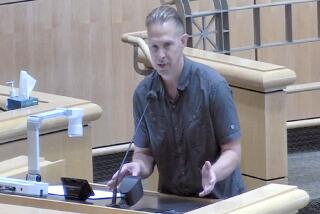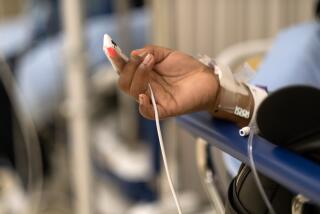A Stunned Community Mourns : Hyperbaric Chamber Not Used in Battle for Lakin’s Life : Medicine: Doctor questions why oxygen treatment was not utilized. Hospital official, honoring family’s request for privacy, will not comment on details of the case.
- Share via
A medical expert Monday questioned why doctors never exposed Ventura County’s community college chief, dying from a “flesh-eating bacteria” infection, to one of medicine’s primary defenses against the condition: pure oxygen treatments in a pressurized chamber.
Thomas G. Lakin, 50, chancellor of the Ventura County Community College District, died Sunday at Los Robles Regional Medical Center in Thousand Oaks after a 24-hour medical battle to save his life.
That battle included amputating one of Lakin’s legs, but no visits to the hyperbaric chamber used on other patients suffering from the virulent infection.
J. B. Wilmeth, the medical director of the hyperbaric unit at Los Robles, said he only learned of Lakin’s case through a reporter. Though he and the unit’s staff are on emergency call 24 hours a day, he said no one in the unit was informed by hospital staff that a patient with the condition, necrotizing fasciitis, had been admitted.
Typically, he said, patients with the disease are put into the chamber, where doses of oxygen are administered to kill the bacteria and stop it from spreading.
“It’s a little bit shocking that someone could die from that ailment without being sent to our hyperbaric unit,” Wilmeth said when he learned of Lakin’s death Sunday night.
*
On Monday, Wilmeth said Lakin’s files have not been made available to him, due to the family’s request for privacy.
“I feel bad about this fellow,” he said. “I felt bad that we weren’t called. At present, we don’t know why. It all depends on what the circumstances were, which I’m not privy too.
“I sure would love to know what happened, but I don’t think I’m going to find out any time soon,” he added. “One wonders why, you know, a young man like that. One wonders why the hyperbaric chamber wasn’t considered.”
At the request of the Lakin family, the medical director of the hospital’s infectious diseases unit would not confirm any specifics of Lakin’s illness, or even that the hyperbaric chamber was not utilized.
“If indeed it was not used in this case it must have been because there were circumstances why it could not be,” said Dr. Mark Mazur.
As an example, Mazur said patients with extremely low blood pressure should not be placed into the pressurized chamber, but he would not say whether that was the case with Lakin, a vigorous man who jogged almost every morning and planned to run his 10th Los Angeles Marathon this spring.
“The reasons that people receive one treatment or another have to do with that individual particularly. The hyperbaric chamber is felt often to be beneficial, but every case is different,” Mazur said.
“From my knowledge, this individual had a very quick illness,” he said.
The staff at Los Robles has treated a total of six patients with necrotizing fasciitis this year, Wilmeth said. Five of them were given pure oxygen treatments in the hyperbaric chamber to kill the bacteria and survived; Lakin was the sixth.
“We don’t get everything referred to us in this world, which is unfortunate, particularly if we think we could have helped somebody. All I can tell you is that in this case, we were not called,” Wilmeth added.
The Times reported Monday that Lakin’s death was the first known fatality from “flesh-eating bacteria” in California, but state officials later estimated that between 14 and 42 deaths from the infection occur annually in California. They said they have no firm figures.
Marilyn Billimek, a Ventura County public health nurse and epidemiologist, said that Lakin was the first known death in the county due to this condition. There were four deaths in Los Angeles County during the first six months of 1994, said Dr. Laurene Mascola, chief of Los Angeles County’s Acute Communicable Disease Control Unit.
Bob Howard, a spokesman for the Centers for Disease Control in Atlanta, said it is estimated that there are between 150 and 300 deaths annually from the “flesh-eating bacteria” in the United States. He said the numbers are not dramatic enough to show any unusual trends in any particular region of the country.
Howard said there are an estimated 10,000 serious cases of Group A streptococcus a year and of that about 2,000 manifest themselves as necrotizing fasciitis.
Lakin’s sudden death left students and faculty shaken at the three community college campuses around Ventura County. Flags were flown at half-staff Monday and administrators spent much of the day debating how to replace Lakin, a popular chancellor who many credit with leading the 28,000-student district from the brink of budgetary and organizational chaos.
Lakin had complained of a severe sore throat to colleagues Wednesday. Friends said he waited until Friday to go to the Los Robles emergency room.
*
Physician Mazur would not comment on what treatment Lakin received that day, but friends said he was treated for symptoms of strep throat, then released.
On Saturday, Lakin returned to the emergency room, saying that he had a sharp pain in his leg and that the tenderness in his throat had not improved. He was then admitted to the hospital. Within hours, the disease “spread like wildfire,” his friends said.
“He was unconscious a great portion of the time,” said one source close to the family. “He went in for exploratory surgery before the amputation of his leg and never regained consciousness.”
Again, Mazur declined to comment on specifics of Lakin’s treatment, but did say that amputation is sometimes an option in dealing with the bacterial infection.
Ventura County Coroner Ronald L. O’Halloran said Monday that the hospital notified his office that Lakin died of necrotizing fasciitis. O’Halloran, however, said he did not know if that would be the official cause of death stated on Lakin’s death certificate.
O’Halloran said the coroner’s office had no further involvement in the case. He said that state law only requires that the coroner investigate suspicious deaths, noting that Lakin had been under private medical care for more than 24 hours before his death.
Doctors hastened to quell mounting fears from the public caused by news of the swift escalation of Lakin’s infection. Staff at Los Robles has already been fielding frightened calls from people about “flesh-eating bacteria.”
“This is not a mystery,” Mazur said at a news conference Monday afternoon. “This is a disease that has been described for many years. It may not even be being seen in increased frequencies.”
And Howard pointed out that the disease has been highly treatable by penicillin for more than 100 years.
“We know what it is and we know how to treat it,” he said. “Penicillin is extremely effective against this disease. The key is to get to a doctor as quickly as possible.”
Howard said the bacteria can enter the body through a break in the skin, such as a cut or burn. As the bacteria multiplies and attacks the skin and fatty tissue, its toxins then enter the blood stream.
He said the first warning signs might be an unusual redness, discoloration or some other indicator that a wound is not healing properly.
“About everyone who dies from this disease dies because they did not seek treatment quickly enough,” Howard said. “The speed at which this disease moves is staggering. It can actually spread at a rate of one inch (of flesh and tissue) per hour. It is one of the few diseases in which you can actually see the spread of it.”
Staff writer Carlos Lozano and correspondents Jeff McDonald and Matt Mosk contributed to this story.
More to Read
Sign up for Essential California
The most important California stories and recommendations in your inbox every morning.
You may occasionally receive promotional content from the Los Angeles Times.













